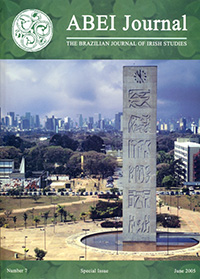The “Tinker” Figure in the Children’s Fiction of Patricia Lynch
DOI:
https://doi.org/10.37389/abei.v7i1.184269Keywords:
Patricia Lynch, Tinkers, Children's bookAbstract
This article explores the representation of Travellers or “tinkers” in some of Patricia Lynch’s children’s books from the first half of the twentieth century. One of the first children’s writers to create a world directly recognizable to her young readers, in which she used to shape a concept of “Irishness,” Lynch establishes the “tinker” as a bridging figure between the realism of rural Ireland and the magical “other world” of the supernatural, but belonging properly to neither. Tinkers are tools through which the child is taught, by negative example, to value the domestic realm and to be a good citizen. Relief from the domestic routine should be found in fairy tales, and not in the actual world of the tinkers. Excluded from both the real world and its acceptable alternative, Travellers are denied a legitimate status within an Irish context. Lynch suggests that the only way for a Traveller to become legitimate is to cease being a Traveller.
References
Baker, Margaret. The Black Cats and the Tinker’s Wife. [1923]. New York: Dodd, Mead & Co., 1938.
Botheroyd, Paul. “The Years of the Travellers: Tinkers, Tramps and Travellers in Early Twentieth-Century Irish Drama and Society.” In Studies in Anglo-Irish Literature. Ed. Heinz Kosok. Bonn: Bouvier, 1982, 167-75.
Burke, Margaret. “The Development of Patricia Lynch’s Writing in the Light of an Exploration of New Archival Material.” In Keenan and Thompson. 94-102.
Byler, Mary Gloyne. “American Indian Authors for Young Readers.” In Cultural Conformity in Books for Young Children: Further Readings in Racism. Ed. Donnarae MacCann and Gloria Woodard. Metuchen, N. J. and London: Scarecrow, 1977. 27-38.
Chapleau, Sebastien. “A Theory without a Centre: Developing Childist Criticism.” In Keenan and Thompson. 130-37.
Delaney, Paul. “Migrancy and Cultural Disappearance.” New Voices in Irish Criticism. Ed. P.J. Mathews. Dublin: Four Courts Press, 2000. 170-79.
____. “Representations of the Travellers in the 1880s and 1900s.” Irish Studies Review, 9, 1, 2001. 53-68.
Keenan, Celia, and Mary Shine Thompson, eds. Studies in Children’s Literature, 1500-2000. Dublin: Four Courts Press, 2004.
Leen, Brendan. “Patricia Lynch.” 14 Dec.2004 http://www.spd.dcu.ie/library/LIBeng/Special%20
Collections/spcollplynch.htm.
Lynch, Patricia. The Turf-Cutter’s Donkey. London: J.M. Dent, 1934. Cited in the text as TD.
____. King of the Tinkers. New York: E.P. Dutton, 1938. Cited in the text as KT.
____. A Storyteller’s Childhood. [1947]. New York: W.W. Norton, 1962. Cited in the Text as SC.
____. Tinker Boy. [1955]. London: J.M. Dent, 1960. Cited in the text as TB.
McDonagh, Cathleen. “Preface.” In Travellers: Citizens of Ireland. Ed. Erica Sheehan. Dublin: The Parish of the Travelling People, 2000, 10-11.
McGillis, Roderick, ed. Voices of the Other: Children’s Literature and the Postcolonial Context. New York and London: Garland, 2000.
Ní Bhroin, Ciara. “Forging National Identity: the Adventure Stories of Eilís Dillon.” In Keenan and Thompson. 112-19.
“Patricia Lynch (Mrs. Richard M. Fox).” 20 Jan.2005 http://www.catholicauthors.com/lynch.html.
Perkins, Lucy Fitch. The Irish Twins. Boston and New York: Houghton Mifflin, 1913.
Smith, Rita. “Lucy Fitch Perkins.” 25 Feb.2005 http://www.recess.ufl.edu/transcripts/2004/1021.shtml.
Stephens, John. Language and Ideology in Children’s Fiction. London and New York: Longman, 1992.
Watson, Nancy. “A Revealing and Exciting Experience: Three of Patricia Lynch’s Children’s Novels.” The Lion and the Unicorn, 21, 3, 1999. 341-46.
Downloads
Published
Issue
Section
License
Copyright (c) 2005 José Lanters

This work is licensed under a Creative Commons Attribution-NonCommercial 4.0 International License.


